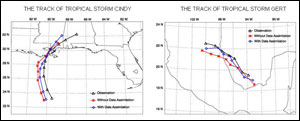NASA Data Combined to Improve Hurricane Landfall Forecasts

These are computer model forecast tracks for tropical storms Cindy and Gert from July, 2005. The black curve is the actual track. The red curve represents the forecast track without NASA data, and the blue curved track includes NASA data. The shapes along the lines indicate storm locations every 6 hours. These figures show that by adding aircraft dropsonde (sensor) data and satellite wind data, the computer model forecast more accurate landfall time and locations and improved the storm track by about 50 percent. Credit: University of Utah
Data gathered from last year’s NASA hurricane research mission and a NASA satellite have improved tropical storm landfall and storm strength forecasts in computer models.
Ocean surface wind data gathered from NASA’s QuikSCAT satellite were combined with data from aircraft sensors dropped into tropical storms and fed into a new generation weather research and forecasting (WRF) computer model used to predict weather. The researchers in this study also used data from the National Oceanic and Atmospheric Administration’s (NOAA) GOES-11 satellite rapid-scan cloud track wind data. When the data were added, the resulting prediction showed improved track and intensity forecast of tropical storms.
“Our results indicate the quite positive impact of those data on forecasts of two landfall storms in last season: tropical storms Cindy and Gert.” said Zhaoxia Pu, scientist at the University of Utah, Salt Lake City, and lead researcher on the study. She reported the results on April 24 at the American Meteorological Society’s Conference on Hurricanes and Tropical Meteorology in Monterey, Calif. The detailed results of this study have been submitted to the Monthly Weather Review for publication.
“By incorporating the aircraft sensor and QuiKSCAT data, the new generation WRF computer model was able to reproduce structure of the rainfalls that caused the flooding during the landfall of two storms,” Pu said.
In July 2005, the Tropical Cloud Systems and Processes (TCSP) mission investigated two hurricanes and several tropical storms. The mission was based at the Juan Santamaria Airfield in San Jose, Costa Rica, and flew 13 NASA ER-2 science flights, including missions to Hurricanes Dennis and Emily. NASA, NOAA, and the Costa Rican Centro Nacional de Alta Tecnologia were participants in the mission.
The P-3 aircraft from the NOAA Hurricane Research Division flew 20 coordinated missions with the NASA research aircraft to investigate developing tropical disturbances. Sensors dropped from airplanes, called dropsondes, gathered data on temperature, winds, pressure and humidity inside the storms.
The team also employed small, unmanned aerial vehicles, a series of balloon-borne weather probes and several low-earth, polar-orbiting and geostationary NASA and NOAA satellites.
The results from this study imply that satellite data are a valuable source for improving tropical cyclone forecasts. In addition, the 2005 field experiment provided valuable data and opportunities for better understanding tropical cyclones.
The new generation WRF computer model is widely used for forecasting and research. It has been used by many local government agencies, research institutes and commercial industries for real-time forecasts.
Pu said that NASA data’s enhancement of WRF hurricane computer model forecasts will encourage the forecast community to incorporate it in all future hurricane forecasts.
Media Contact
More Information:
http://www.nasa.govAll latest news from the category: Ecology, The Environment and Conservation
This complex theme deals primarily with interactions between organisms and the environmental factors that impact them, but to a greater extent between individual inanimate environmental factors.
innovations-report offers informative reports and articles on topics such as climate protection, landscape conservation, ecological systems, wildlife and nature parks and ecosystem efficiency and balance.
Newest articles

How marine worms regenerate lost body parts
The return of cells to a stem cell-like state as the key to regeneration. Many living organisms are able to regenerate damaged or lost tissue, but why some are particularly…

Nano-scale molecular detective
New on-chip device uses exotic light rays in 2D material to detect molecules. Researchers have developed a highly sensitive detector for identifying molecules via their infrared vibrational “fingerprint”. Published in Nature…

Novel CAR T-cell therapy
… demonstrates efficacy and safety in preclinical models of HER2-positive solid tumors. The p95HER2 protein is found expressed in one third of HER2+ tumors, which represent 4% of all tumors….



